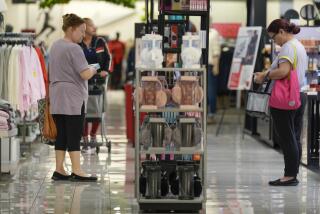Retailers See Lukewarm Sales for Fifth Month
Consumers worried about a volatile stock market, high fuel prices and interest-rate hikes were careful with their spending in July, giving retailers a fifth month in a row of so-so sales.
But spending patterns last month were uneven, with consumers turning away from clothing and ever more toward items for the home--all of which could mean trouble for some sectors in the important holiday season.
“The consumer is still very much alive here, they just may not be buying apparel or they are buying apparel at heavier discounts,” said Michael Niemira, a retail-industry analyst with Bank of Tokyo-Mitsubishi in New York. “Furniture and consumer electronics continue to do very well. Yes, they’re weaker than earlier in the year, but they’re really quite strong--much like housing sales.”
Overall, Goldman Sachs pegged July retail sales at 3.7% better than this period last year. Bank of Tokyo-Mitsubishi pegged its retail chain store sales index as gaining 4.2%--well off last year’s July gain of 6.9%. Salomon Smith Barney analysts charted a 4% gain in same-store sales.
Economists had anticipated a slower rate of sales growth, especially after a 2 1/2-year low in new-home sales in June and July’s slight drop-off in the auto market’s lightning-pace sales.
But analysts said that the signs of economic softness may not convince the Federal Reserve Board, which will meet Aug. 22, to hold off on a seventh interest-rate hike since June 1999.
July’s retail sales were still stronger than in lackluster June. Car sales slowed last month from a phenomenally high rate, but were considered strong. And although house building has slowed, existing-home purchases rose in June to the highest level in 10 months. What’s more, federal figures released last week showed second-quarter economic growth up to an annual rate of 5.2%, compared with 4.8% in the first part of the year.
Department stores and other apparel sellers suffered the most in July, despite the usual clearance sales. Sales at department stores as a whole fell 0.3% industrywide in stores open at least a year as compared with July 1999, according to figures tallied by Goldman Sachs.
Nordstrom Inc.’s sales fell 9.7% and Mervyn’s, a division of Target Corp., dropped by 2.4%. Federated Department Stores Inc., parent of Bloomingdale’s and Macy’s, rose just 1.6%. Sales at Gap Inc. fell 1%, mostly due to a drop-off at its Old Navy stores of between 17% and 19%.
And the unsettling trend is likely to continue for Southern California’s fancier mall stores, according to a study released Thursday by Deloitte & Touche, as increasing numbers of parents choose discount stores for their back-to-school buying.
Niemira added that holiday sales are also likely to be uneven.
“We’ll probably have a decent Christmas,” Niemira said. “But with all the expansion and the tough comparisons, it may be much more spotty for individual retailers, even if the overall numbers look OK.”
July also paled in comparison with the rest of 2000, which posted an average sales pace through June of 5.1% above last year, according to Bank of Tokyo-Mitsubishi figures.
Furniture sales, however, rose 15.1% and electronics gained 12% as compared with a year ago. RadioShack Corp. posted a strong 12% sales gain.
Discount stores also fared well, with top-retailer Wal-Mart Stores Inc. posting a 6.5% gain in same-store sales and Costco Wholesale Corp. announcing an increase of 9%.
Same-store sales are considered an important measure of a chain’s health because the figure excludes new and closed stores.
The Deloitte & Touche report found a similar pattern, in which people were expecting to spend about the same for back-to-school clothing as last year--as much as $200 per child--but were more likely than before to stretch that $200 by patronizing lower-cost sellers.
In its “Back-to-School 2000 Shopper Outlook Survey--Southern California,” the consulting firm found that 44% of families said they would do most of their school shopping in discount stores, as opposed to 34% last year. Department stores lost ground, with 38% of those surveyed citing the more upscale establishments as their first choice, down from 41% last year.
The study found twice as many parents willing to shop online for school clothes--13% this year, compared with 6% in 1999. But 41% said they were avoiding the Web because their children would not be able to try on the clothes.
More to Read
Inside the business of entertainment
The Wide Shot brings you news, analysis and insights on everything from streaming wars to production — and what it all means for the future.
You may occasionally receive promotional content from the Los Angeles Times.










